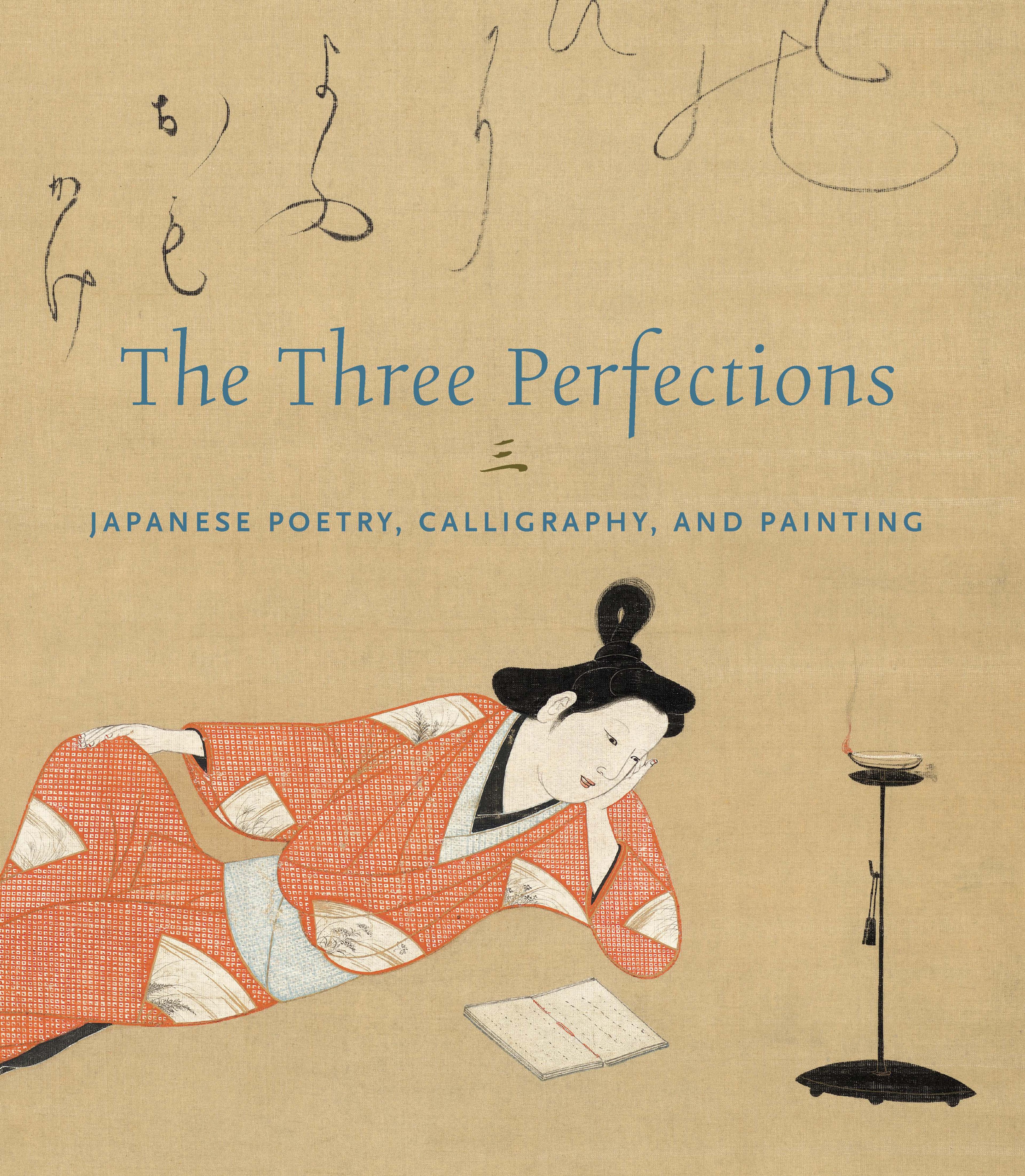Kana Letter on Stamped Images of Amida Buddha
Brushed in elegant cursive characters, mostly in kana (Japanese phonetic writing), this treasured letter of Monk Jōgyō has in recent years been sumptuously remounted as a hanging scroll. Jōgyō, as the third son of first Kamakura Shogun Minamoto no Yoritomo (1147–1199), was born into the most powerful military family of the day, but he eschewed the political infighting between the palace in Kyoto and shogunate in eastern Japan, and took Buddhist vows at an early age. He trained at Ninnaji in Kyoto and rose in monastic ranks to become an important Shingon prelate. To have rare example of thirteenth-century calligraphy of an esteemed religious figure is worthy of preservation and display in and of itself. Yet, the viewer immediately understands that something more complex is at work here, since printed images of Amida show through from the reverse side, creating an intriguing visual dialectic of the transcendental realm of the Buddhas and the secular world represented by an informal communication in the vernacular (not a Buddhist treatise or sutra). Such printed sheets are usually called “stamped Buddhas” (inbutsu 印佛), though sometimes the term “printed Buddhas” (suribotoke 摺仏, also pronounced or shūbutsu) is used, though that term is properly reserved for when the sheet of paper is placed on top of the ink block. Sometimes large prints with a hundred or more were created; for instance see the example from the Cowles Collection comprising one hundred images of Fudō Myōō, created by stamping the same block to create ten rows.
This letter belongs to a cache of personal letters, sutras, other religious documents and objects that were placed inside statues of the Amida Triad, created in the Kamakura period, at Gobōjakujō’in subtemple at Kōyasan, the headquarters of the Shingon sect. When the sculptures were being examined in the 1910s, many similar letters and documents were discovered, including a scroll of Shingon dharani (Esoteric Buddhist magical texts), which was designated an Important Cultural Property. It was a well established practice to place objects related to the patrons who funded a Buddhist statue or objects related to deceased monks and members of the temple community inside of temple statues, collectively referred to as “offerings for interring in statues” (zōnai nōnyūhin 像内納入品). It was at that time of the investigation of the Kōyasan statues that it was realized that this letter and several others came from this same cache but must have been removed earlier on and sold to collectors in Japan.
Other known examples, in the collections of the late Sylvan Barnet and William Burto, Hiroshi Sugimoto, and private collection in Japan (e.g., fig. 2) have either printed Buddhas, as here, or Buddhist texts in Chinese, and in some cases dharani (magical formulae) in Sanskrit. For the letters and documents associated with Jōgyō it is believed that the images or texts were either printed or inscribed on the reverse side of Jōgyō letters after he died, in order to create karmic merit for the deceased soul.
This letter belongs to a cache of personal letters, sutras, other religious documents and objects that were placed inside statues of the Amida Triad, created in the Kamakura period, at Gobōjakujō’in subtemple at Kōyasan, the headquarters of the Shingon sect. When the sculptures were being examined in the 1910s, many similar letters and documents were discovered, including a scroll of Shingon dharani (Esoteric Buddhist magical texts), which was designated an Important Cultural Property. It was a well established practice to place objects related to the patrons who funded a Buddhist statue or objects related to deceased monks and members of the temple community inside of temple statues, collectively referred to as “offerings for interring in statues” (zōnai nōnyūhin 像内納入品). It was at that time of the investigation of the Kōyasan statues that it was realized that this letter and several others came from this same cache but must have been removed earlier on and sold to collectors in Japan.
Other known examples, in the collections of the late Sylvan Barnet and William Burto, Hiroshi Sugimoto, and private collection in Japan (e.g., fig. 2) have either printed Buddhas, as here, or Buddhist texts in Chinese, and in some cases dharani (magical formulae) in Sanskrit. For the letters and documents associated with Jōgyō it is believed that the images or texts were either printed or inscribed on the reverse side of Jōgyō letters after he died, in order to create karmic merit for the deceased soul.
Artwork Details
- 仮名消息・印仏
- Title:Kana Letter on Stamped Images of Amida Buddha
- Period:Kamakura period (1185–1333)
- Date:early 13th century
- Culture:Japan
- Medium:Hanging scroll; brush written letter, ink on paper (front); stamped images, ink on paper (reverse)
- Dimensions:Image: 10 5/8 × 16 1/2 in. (27 × 41.9 cm)
Overall with mounting: 48 1/2 × 22 in. (123.2 × 55.9 cm)
Overall with knobs: 48 1/2 × 23 3/4 in. (123.2 × 60.3 cm) - Classification:Calligraphy
- Credit Line:Mary and Cheney Cowles Collection, Gift of Mary and Cheney Cowles, 2020
- Object Number:2020.396.3
- Curatorial Department: Asian Art
More Artwork
Research Resources
The Met provides unparalleled resources for research and welcomes an international community of students and scholars. The Met's Open Access API is where creators and researchers can connect to the The Met collection. Open Access data and public domain images are available for unrestricted commercial and noncommercial use without permission or fee.
To request images under copyright and other restrictions, please use this Image Request form.
Feedback
We continue to research and examine historical and cultural context for objects in The Met collection. If you have comments or questions about this object record, please contact us using the form below. The Museum looks forward to receiving your comments.
